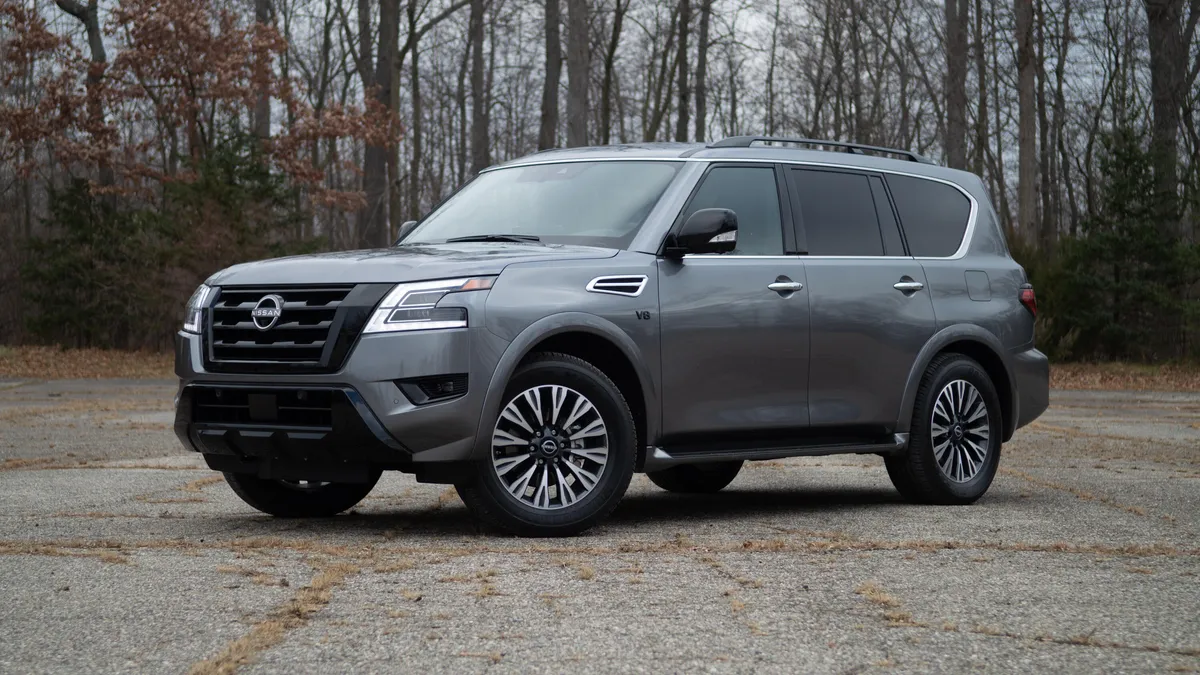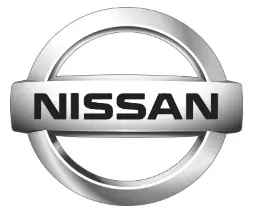Nissan Armada 2021
The Nissan Armada 2021 was introduced as the latest iteration of Nissan’s full-size SUV. It offers a combination of powerful performance, spaciousness, and advanced features. Here are some key features and updates for the 2021 Armada:
- Design: The 2021 Armada showcases a bold and robust exterior design with a prominent V-motion grille, LED headlights, and a muscular body profile. It exudes a commanding presence on the road.
- Interior: The Armada 2021 offers a luxurious and spacious cabin that can accommodate up to eight passengers. It features premium materials, comfortable seating, and a range of available amenities such as leather upholstery, heated and ventilated seats, and a power-folding third-row seat.
- Performance: The 2021 Armada is powered by a 5.6-liter V8 engine, generating 400 horsepower and 413 lb-ft of torque. It is paired with a seven-speed automatic transmission, providing smooth acceleration and confident towing capabilities.
- Technology: The Armada 2021 comes equipped with a host of advanced technology features. It includes an 8-inch touchscreen infotainment system with navigation, Apple CarPlay and Android Auto integration, Bluetooth connectivity, and a Bose audio system. Additional available features include a rear-seat entertainment system and a surround-view camera.
- Safety: The 2021 Armada prioritizes safety with the inclusion of Nissan Safety Shield 360, which consists of various driver-assistance technologies. It includes features like Automatic Emergency Braking with Pedestrian Detection, Blind Spot Warning, Rear Cross Traffic Alert, Lane Departure Warning, and High Beam Assist.
- Off-Road Capability: The Armada 2021 offers available Intelligent 4×4 with a two-speed transfer case, allowing for enhanced off-road capability and confident driving in various conditions.
These are some of the key features and updates for the Nissan Armada 2021 model. For more detailed information and to explore the available trim levels and options, I recommend visiting Nissan’s official website or contacting a Nissan dealership.
SUPPLEMENTAL RESTRAINT SYSTEM
PRECAUTIONS ON SUPPLEMENTAL
RESTRAINT SYSTEM
This Supplemental Restraint System (SRS) section contains important information concerning the following systems.
- Driver and passenger supplemental front-impact air bag (NISSAN Advanced Air Bag System)
- Driver and front passenger supple-mental knee airbag
- Front seat-mounted side-impact sup- elemental airbag
- Roof-mounted curtain side-impact and rollover supplemental airbag
- Seat belt with pre-tensioner
Supplemental front-impact air bag system: The NISSAN Advanced Air Bag System can help cushion the impact force to the head and chest of the driver and front passenger in certain frontal collisions.
Driver and front passenger supplemental knee air bag system: This system can help cushion the impact force to the driver’s and front passenger’s knees in certain collisions.
Front seat-mounted side-impact supplemental airbag system: This system can help cushion the impact force to the chest and pelvis area of the driver and front passenger in certain side-impact collisions. The supplemental side airbag is designed to inflate on the side where the vehicle is impacted.
Roof-mounted curtain side-impact and rollover supplemental air bag system: This system can help cushion the impact force to the head of occupants in front and rear (2nd and 3rd) outboard seating positions in certain side impact or rollover collisions. In a side impact, the curtain airbags are designed to inflate on the side where the vehicle is impacted. In a roll-over, the curtain airbags on both sides are designed to inflate. Under both side-impact and rollover situations, the curtain airbags will remain inflated for a short period of time.
These supplemental restraint systems are designed to supplement the crash protection provided by the driver and passenger seat belts and are not a substitute for them. Seat belts should always be correctly worn and the occupant seated a suitable distance away from the steering wheel, instrument panel and door finishers. (See “Seat belts” (P.1-20) for instructions and precautions on seat belt usage.)
The supplemental airbags operate only when the ignition switch is in the ON position.
After placing the ignition switch in the ON position, the supplemental airbag warning light illuminates. The supplemental air bag warning light will turn off after about 7 seconds if the systems are operational.
WARNING
- The front airbags ordinarily will not inflate in the event of a side impact, rear impact, rollover, or lower-severity frontal collision. Always wear your seat belts to help reduce the risk or severity of injury in various kinds of accidents.
- The front passenger airbag and front passenger knee airbag will not inflate if the front passenger airbag status light is lit or if the front passenger seat is unoccupied. See “Front passenger air bag and status light” (P.1-62).
- The seat belts and the front airbags are most effective when you are sitting well back and upright in the seat. The front airbags inflate with great force. Even with the NISSAN Advanced Air Bag System, if you are unrestrained, leaning forward, sitting sideways or out of position in any way, you are at greater risk of injury or death in a crash. You may also receive serious or fatal injuries from the front airbag if you are up against it when it inflates. Always sit back against the seat-back and as far away as is practical from the steering wheel or instrument panel. Always use seat belts.
- The driver and front passenger seat belt buckles are equipped with sensors that detect if the seat belts are fastened. The Advanced Air Bag System monitors the severity of a collision and seat belt usage then inflates the airbags. Failure to properly wear seat belts can increase the risk or severity of injury in an accident.
- The front passenger seat is equipped with occupant classification sensors (weight sensors) that turn the front passenger airbag and front passenger knee airbag OFF under some conditions. These sensors are only used in this seat. Failure to be properly seated and wearing the seat belt can increase the risk or severity of injury in an accident. See “Front passenger air bag and status light” (P.1-62).
- Keep your hands on the outside of the steering wheel. Placing them inside the steering wheel rim could increase the risk of injury if the front airbag inflates.
WARNING
- Never let children ride unrestrained or extend their hands or face out of the window. Do not attempt to hold them in your lap or arms. Some examples of dangerous riding positions are shown in the illustrations.
- Children may be severely injured or killed when the front airbags, side airbags or curtain airbags inflate if they are not properly restrained. Pre-teens and children should be properly restrained in the rear seat, if possible.
- Even with the NISSAN Advanced Air Bag System, never install a rear-facing child restraint in the front seat. An inflating front airbag could seriously injure or kill your child. See “Child restraints” (P.1-32) for details.
Front seat-mounted side-impact supplemental airbags and roof-mounted curtain side-impact and rollover supplemental airbags:
- The side airbags ordinarily will not inflate in the event of a front impact, rear impact, rollover, or lower severity side collision. Always wear your seat belts to help reduce the risk or severity of injury in various kinds of accidents.
- The curtain airbags ordinarily will not inflate in the event of a front impact, rear impact, or lower severity side collision. Always wear your seat belts to help reduce the risk or severity of injury in various kinds of accidents.
- The seat belts, the side airbags and curtain airbags are most effective when you are sitting well back and upright in the seat. The side airbags and curtain airbags inflate with great force. Do not allow anyone to place their hand, leg or face near the side airbags on the side of the seatback of the front seat or near the side roof rails. Do not allow anyone sitting in the front seats or rear outboard seats to extend their hand out of the window or lean against the door. Some examples of dangerous riding positions are shown in the previous illustrations.
- When sitting in the rear seat, do not hold onto the seatback of the front seat. If the side airbag inflates, you may be seriously injured. Be especially careful with children, who should always be properly restrained. Some examples of dangerous riding positions are shown in the illustrations.
- Do not use seat covers on the front seatbacks. They may interfere with side air bags inflation.
NISSAN ADVANCED AIR BAG SYS-TEM (front seats)
WARNING
To ensure the proper operation of the passenger’s advanced airbag system, please observe the following items.
- Do not allow a passenger in the rear seat to push or pull on the seatback pocket.
- Do not place heavy loads heavier than 9.1 lbs (4 kg) on the seat-back, head restraint or in the seatback pocket.
- Do not store cargo behind the seat that can press into the seat-back.
- Do not position the front passenger seat so it contacts the rear seat. If the front seat does contact the rear seat, the airbag system may determine a sensor malfunction has occurred and the front passenger air bag status light may illuminate and the supplemental airbag warning light may flash.
- If a forward-facing child restraint is installed in the front passenger seat, do not position the front passenger seat so the child restraint contacts the instrument panel. If the child restraint does contact the instrument panel, the system may determine the seat is occupied and the passenger airbag and front passenger knee air bag may deploy in a collision. Also, the front passenger airbag status light may not illuminate. See “Child restraints” (P.1-32) for information about installing and using child restraints.
- Confirm the operating condition with the front passenger airbag status light.
- If you notice that the front passenger air bag status light is not operating as described in this section, it is recommended you visit a NISSAN dealer to check the passenger seat Advanced Air Bag System.
- Until you have confirmed with your dealer that your passenger seat advanced airbag is working properly, position the occupants in the rear seating positions.
Reference Link
Download Manuals: https://www.nissanusa.com/owners/ownership/manuals-guides.html


